Giant’s long-running cross country mountain bike saw a refresh in late 2021, with the new bike getting updated geometry, a longer travel suspension fork and, on this model, Fox’s Live Valve electronic suspension system.
Giant Anthem Advanced Pro 29 1 frame
Giant has dropped its virtual pivot point Maestro suspension linkage for the new Anthem. The new bike now uses the brand's Flex Point Pro single-pivot linkage driven, flexstay arrangement. This sees the seat and chainstays flex to simulate the articulation of a pivot point.
The 100mm-travel bike is constructed using Giant's Advanced composite carbon fibre, including the front and rear triangles and rocker link.
Giant claims the new rear end saves 250g over the old version, while the bottom bracket area is also said to be stiffer due to the use of a broad PF92 bottom bracket shell.
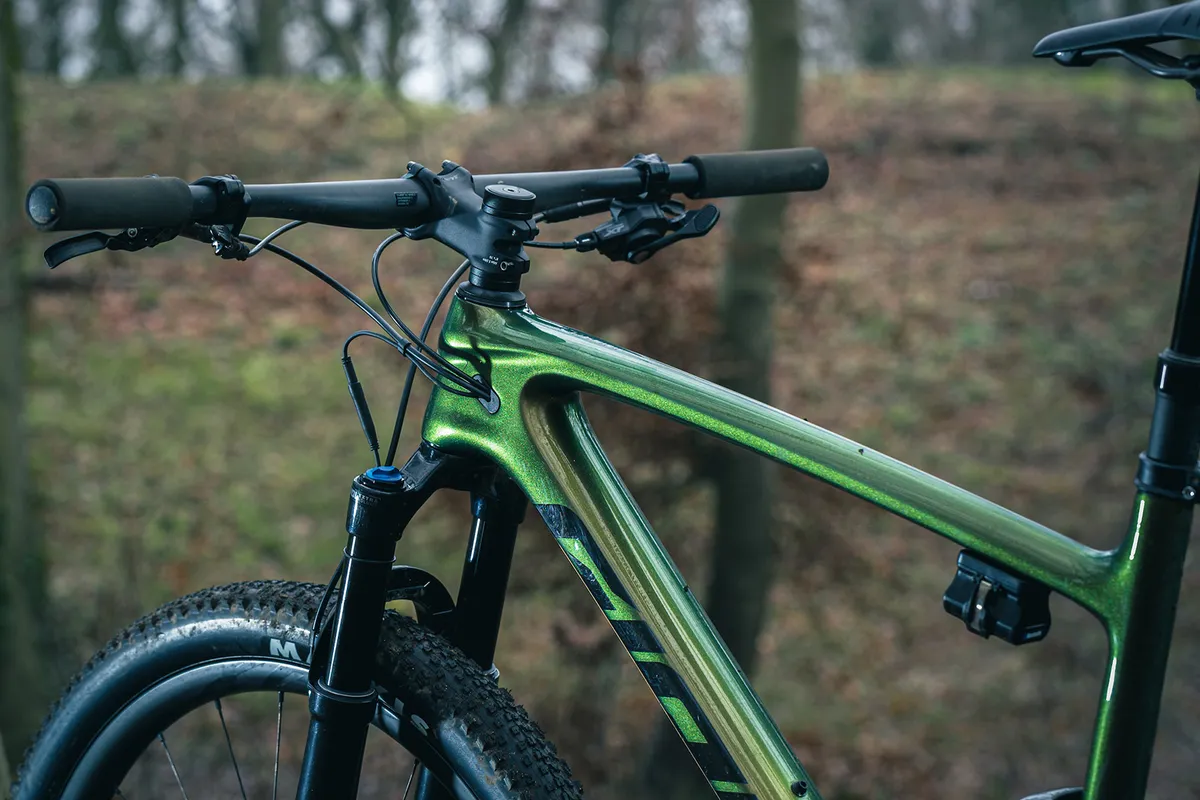
All cables run internally, while the low-slung top tube ensures standover heights are reasonable.
A single set of bottle bosses inside the frame might put marathon racers off, given that water carrying capabilities are limited to one bottle. The underside of the top tube holds the Live Valve’s battery and brain, in a clip-on-clip-off arrangement.
The Live Valve cables generally run internally, but where they are exposed (such as at its entry to the rear shock) care needs to be taken to avoid snagging.
Giant Anthem Advanced Pro 29 1 geometry
The geometry on the new bike is modern, with a slack 67.5-degree head angle, a steepish 75.5-degree seat angle, long 470mm reach and stubby 70mm stem on my size large test bike.
These numbers are similar to other modern cross country bikes designed for more technical race courses, such as the Specialized Epic and Santa Cruz Blur.
The new rear end has also enabled Giant to shorten the rear triangle, keeping the chainstays to 435mm across all three sizes.
| | S | M | L | XL |
|---|---|---|---|---|
| Seat angle (degrees) | 75.5 | 75.5 | 75.5 | 75.5 |
| Head angle (degrees) | 67.5 | 67.5 | 67.5 | 67.5 |
| Chainstay (mm) | 435 | 435 | 435 | 435 |
| Seat tube (mm) | 390 | 420 | 465 | 495 |
| Top tube (mm) | 572 | 604 | 626 | 653 |
| Head tube (mm) | 90 | 95 | 105 | 115 |
| Fork offset (mm) | 44 | 44 | 44 | 44 |
| Trail (mm) | 109 | 109 | 109 | 109 |
| Bottom bracket drop (mm) | 42 | 42 | 42 | 42 |
| Wheelbase (mm) | 1127 | 1159 | 1183 | 1212 |
| Standover (mm) | 745 | 750 | 777 | 800 |
| Stack (mm) | 589 | 593 | 603 | 612 |
| Reach (mm) | 420 | 450 | 470 | 495 |
| Stem length (mm) | 60 | 70 | 70 | 70 |
| Crank length (mm) | 170 | 175 | 175 | 175 |
Giant Anthem Advanced Pro 29 1 specifications

The Anthem's big talking point is its Fox Live Valve suspension. This electronic system links sensors on the fork and frame with the fork and shock’s compression circuit, automatically opening and closing them when an impact or change in gradient is felt.
The system defaults to Firm, before computing power works out, through sensors, whether the fork and/or shock should be opened.
The box gives you the option to toggle between five modes, though there’s now an app with additional modes and tuneable settings. These include a Climb mode, whereby the fork is opened up while the shock gets firmer, pitching weight forward.
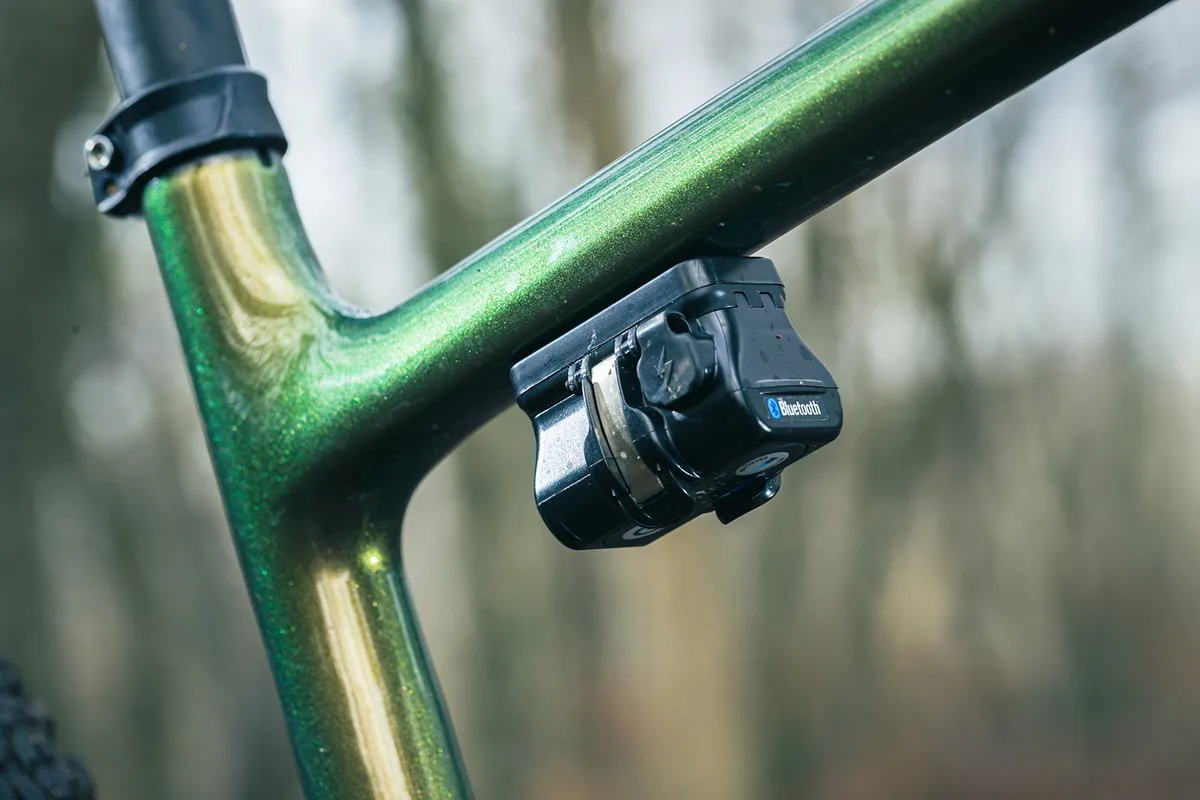
Generally, I used the Sport mode, which gave me the best balance between firmness and willingness to open up.
Claimed battery life of 16-20 hours seems accurate and charging doesn’t take long. When the battery dies, the system defaults to open mode.
It's worth stressing that Live Valve is a complex system and that individual settings have a large impact on how a bike feels. If you do buy a bike with Live Valve, expect to invest some time experimenting with the system to get the most out of it for your riding.
Up front, the Fox 34SC Performance Elite fork has 110mm of smooth travel. The fork uses the FIT4 damper, controlled by the top-cap mounted Live Valve solenoids. Its 34mm chassis adds stiffness, while the StepCast (SC) chassis saves weight over the standard 34.
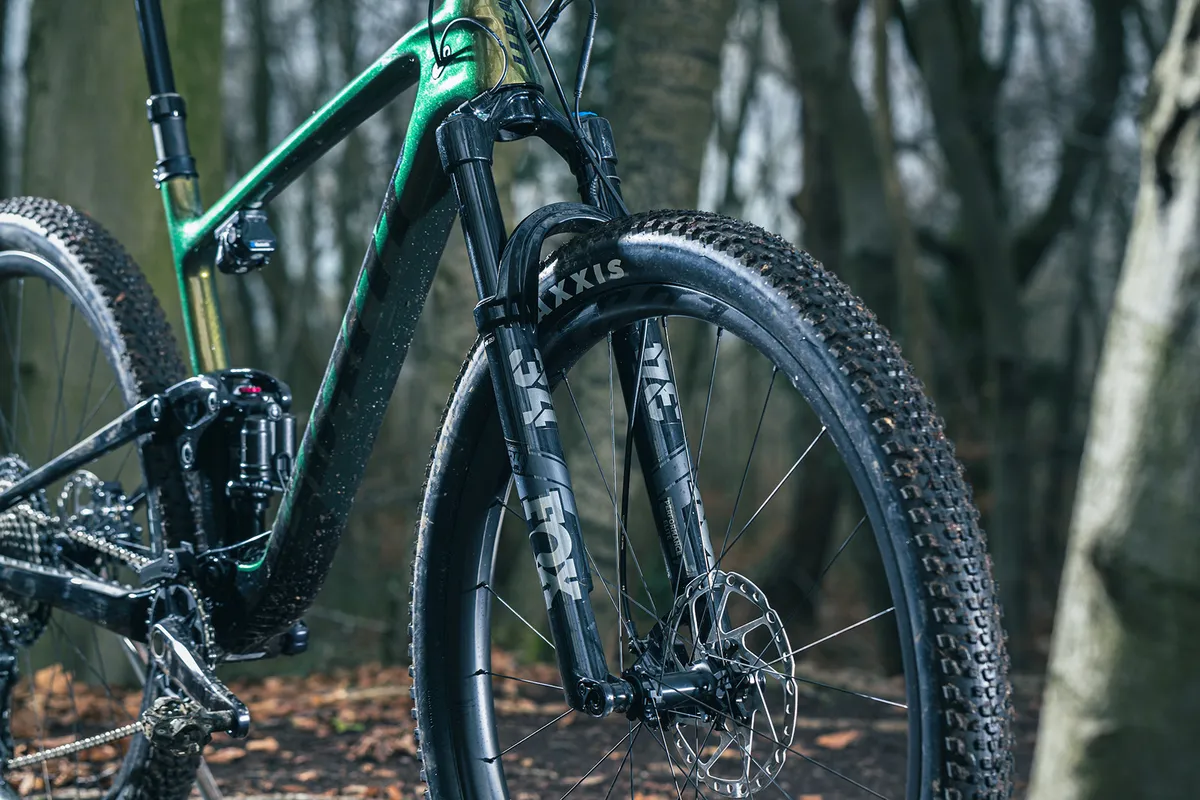
Performance Elite-level suspension doesn’t get the Kashima coated stanchions of the pricier Factory level suspension, but everything else is the same.
The drivetrain and brakes come from Shimano’s XT line (except the KMC chain), and include a 180mm front rotor for extra stopping power and a 32t chainring.
The vast bulk of the finishing kit, including 35mm-diameter carbon bars and broad, carbon XCR 1 wheelset come from Giant. The wheels are wrapped in 2.4 in Maxxis Rekon Race tyres – a favourite of mine.
Giant Anthem Advanced Pro 29 1 ride impressions

I tested this bike on a range of trails in the South West of the UK, including fast trail centre loops from home on fine, gritty man-made trails, through to forest tracks with plenty of rocks and roots to contend with.
Some of the routes I rode I’ve raced on in the past, giving me a taste of how the bike should handle.
Giant Anthem Advanced Pro 29 1 setup
Setting the bike up was fairly easy, as the Live Valve system can be turned off while setting up the air springs and rebound damping, opening their circuits. The Live Valve system requires some calibration, but this is a quick and easy process to follow.
The system has an on/off button on the controller under the top tube, as well as another button to cycle through the five sensitivity settings. Sadly, it’s not really feasible to do this while you’re riding the bike.
I ended up with sag at around 25 per cent – a touch softer than I might often use on an aggressive XC bike, but a nice balance for increasingly rough XC courses. With the system defaulting to locked, I felt I didn’t need to compromise performance on rougher terrain to boost pedalling performance via a more aggressive (higher-pressure) spring rate.
I set my tyres up to my preferred pressures for the courses I rode, generally in the low-20s psi.
Giant Anthem Advanced Pro 29 1 climbing performance
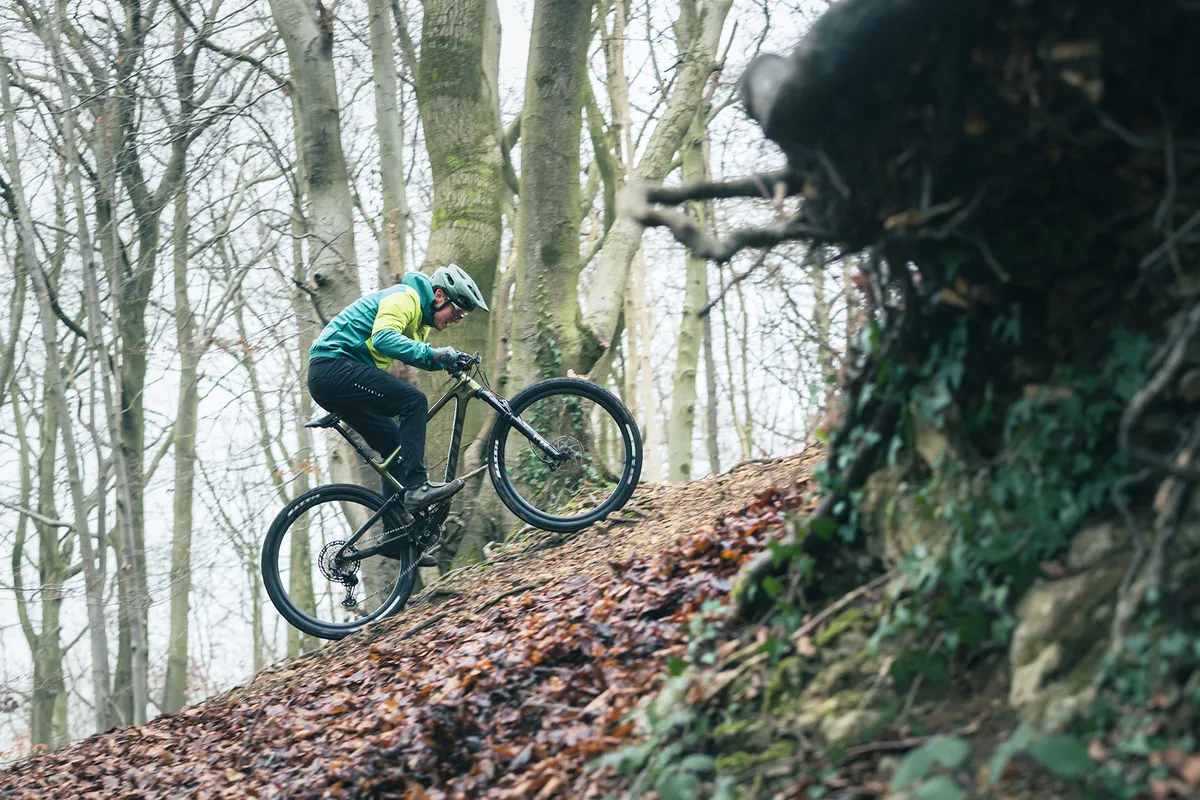
I tested the bike with the Live Valve both on and off. This was to get an impression of the suspension system’s performance isolated from the tech, and making that more relevant to the cheaper Giant Anthem Advanced Pro 29 2, which doesn’t have such technology.
The bike has a really good shape for climbing. The seat angle might be slack compared with an enduro bike, but given an XC bike sags less (which has the effect of further slackening a seat angle), the on-bike seat angle always remains steep enough.
This, along with the lengthened front triangle, gives a good position for the hips over the pedals for efficient pedalling, as well as room to move forward and back over the bike to balance steering precision and rear-wheel traction on technical climbs.
The suspension isn’t as solid under power as some XC bikes, so with Live Valve turned off, or when set with a low sensitivity, there is some bob. This is countered, though, by excellent levels of traction, with the rear tyre able to scrabble for every ounce of grip on offer.
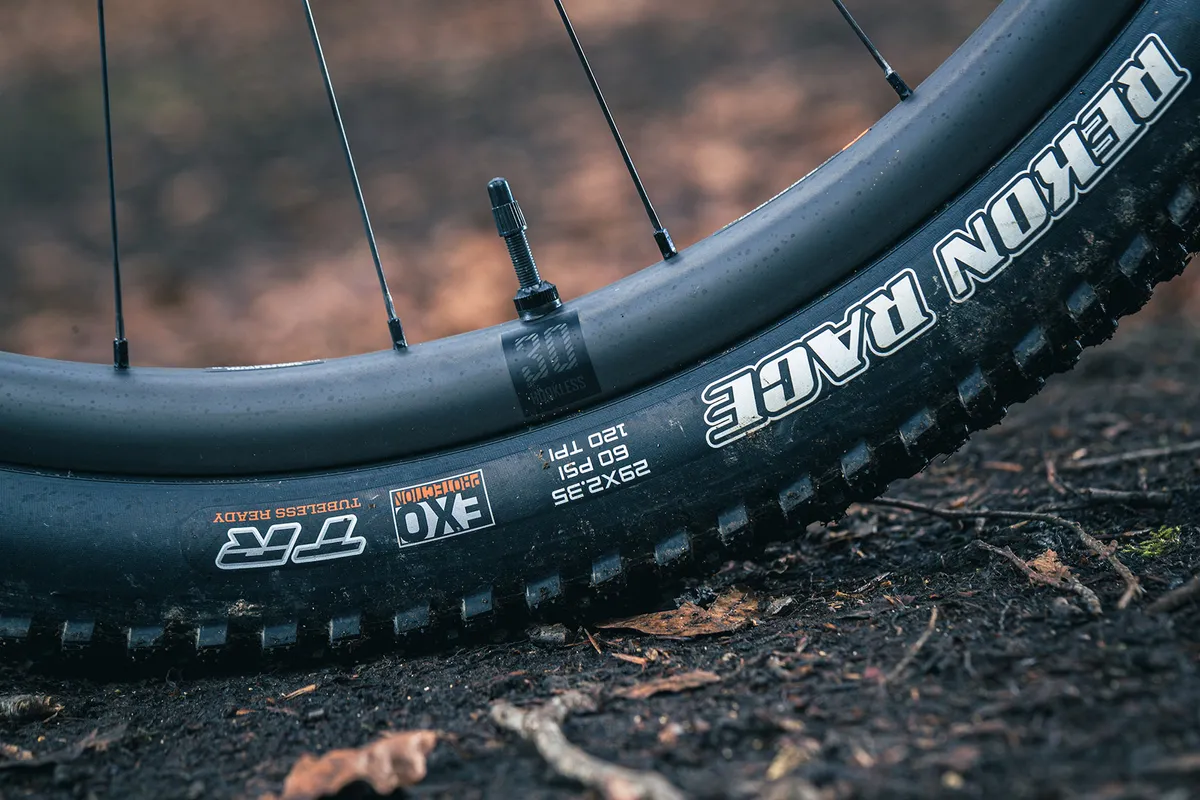
The tyres roll well, too. The Rekon Race has low-depth tread blocks that reduce rolling resistance, while the shoulder treads bite when the bike is leaned onto its side. On fine grit, as you often find at a trail centre, they can slip a bit, but thanks to the wide rims, pressures can be run fairly low, countering this.
Adding Live Valve to the mix changes things a little. In softer, more sensitive modes bumps through the sensors leave the shock open for longer, and it opens on smaller impacts. Over prolonged bumpy sections of track, some pedal bob can be felt.
However, in all but those most sensitive settings the system is quick and smart enough to quell most body-weight and pedal force induced shock compressions, by closing compression circuits, leading to an incredibly efficient ride. This is increased the firmer your settings are.
When locked, it’s fair to say that neither fork nor shock give a completely solid lockout, so there’s always a little bit of movement, aiding traction without wholly compromising climbing efficiency.
Giant Anthem Advanced Pro 29 1 descending performance
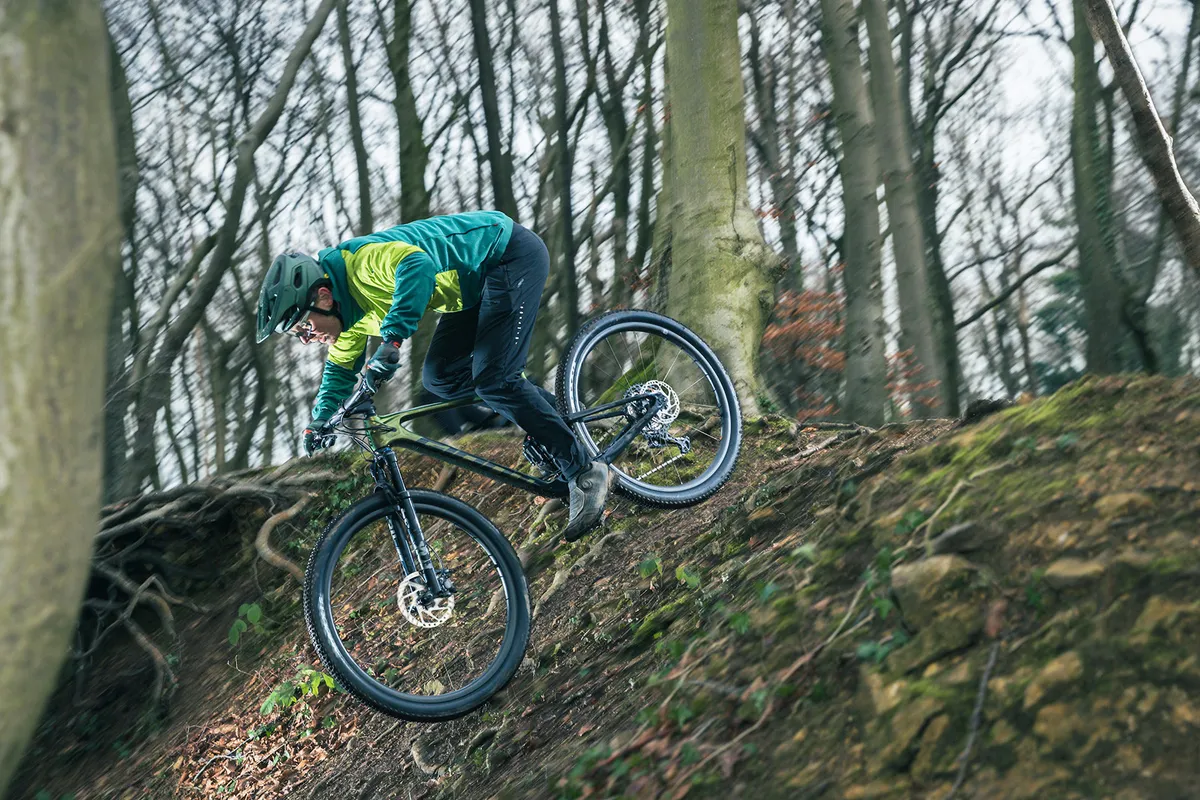
When it comes to the descents, the geometry is impressive – the longer reach, extra bit of travel from the structurally stout fork and fairly slack head angle help give the bike stability and confidence on steeper tracks, especially as the included dropper post gets the saddle out of the way.
While it’s no shred sled, it’s stable and secure over loose surfaces, so long as the fast-rolling Rekon Race tread can keep pace. The aforementioned broad carbon rims allow lower pressures, and I was constantly surprised by how much terrain the Rekon Races could handle.
The longer front end doesn’t result in barge-like handling, either. The 70mm stem and compact stays help keep things crisp, so tight, twisting tracks through trees, popular in the south of the UK, are handled accurately.
While I’d like a wider than 760mm bar, it’s a cockpit that aids an attacking position over the long front half of the bike.
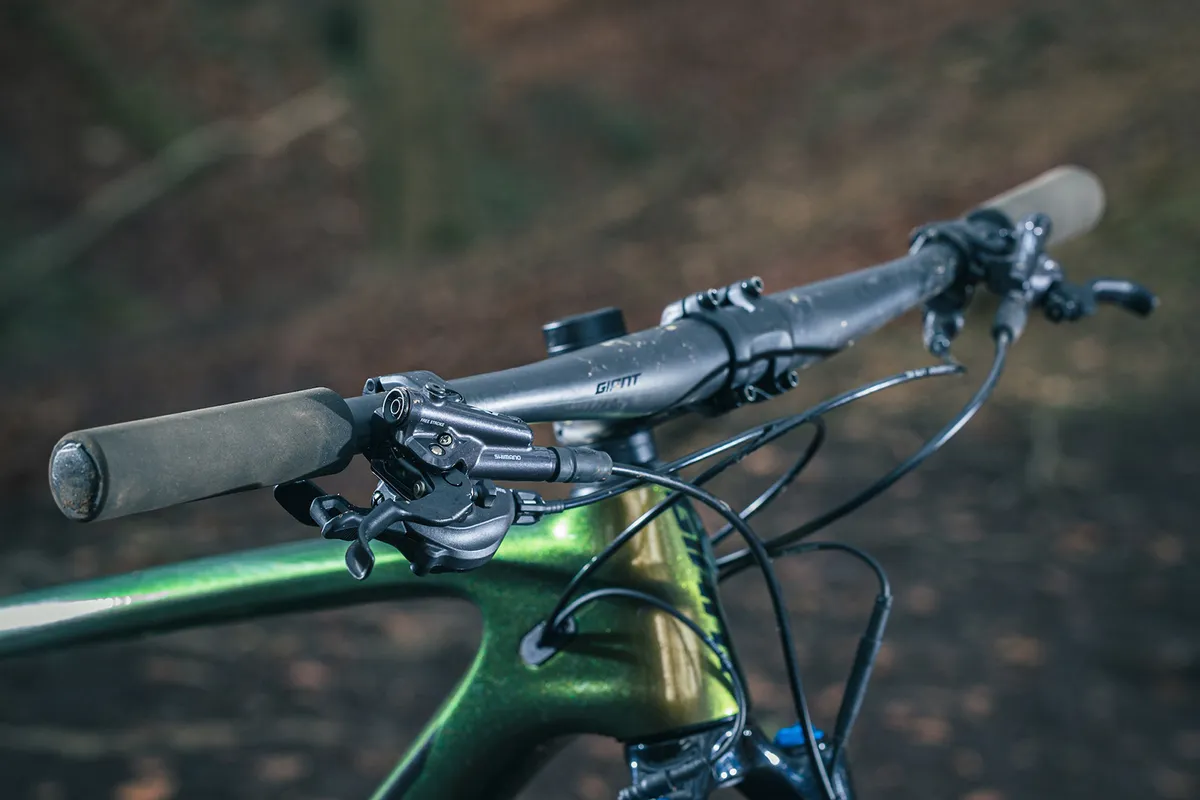
As such, the Anthem is confidently pointed towards the more technical descents, where fortunately the suspension’s performance handles the pace.
The suspension is smooth early in the stroke, tuning out trail chatter effectively, although I’d argue the Scott Spark is a touch smoother. There’s enough progression later in its stroke to avoid constant awkward clangs as the rim clatters over rocks and roots.
Midstroke support is good, with enough there to hold speed in berms and generate pop off a jump’s lip.
If I had to be picky, I found the 35mm bar and stem combo a little stiff for my liking. It transmits quite a bit of trail buzz to the skinny grips, and so over high-frequency chatter the front end wasn’t as comfortable as I’d like. My experience of these forks and tyres suggests the issue is caused by the bars rather than elsewhere.
Shimano’s XT kit only really lacks an ‘R’ from the XTR’s logo – otherwise performance is nigh-on identical in my experience. Things are similar when it comes to the suspension, with the lack of a Kashima coating on the fork and shock barely registering beyond the cosmetic stakes.
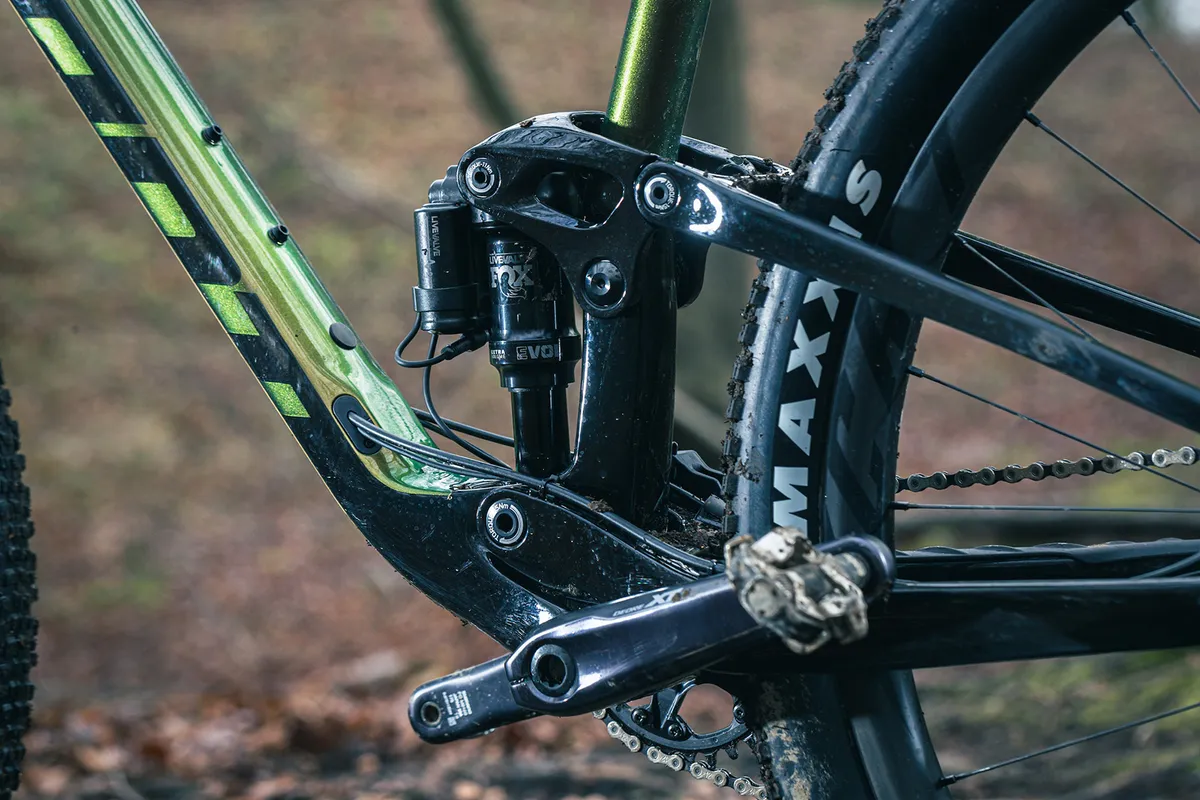
Yes, it feels a touch cheeky to swap in a KMC chain rather than genuine XT, but thus far I’ve not found it to be detrimental to performance. I would, however, replace it with the correct chain when it needed swapping for the full Shimano experience, where shifting under power is second to none.
Giant’s carbon hoops have a freehub with a low engagement angle, so accelerations out of corners feel immediate, while their 30mm internal width helps the Rekon Race tyres blow up huge.
This only bolsters the performance of one of my favourite XC treads. They’re supple, fast rolling and surprisingly competent, thanks to a shoulder tread that hooks up well in turns.
Giant Anthem Advanced Pro 29 1 – Fox Live Valve suspension performance
The Live Valve system rarely detracts from the bike’s descending capabilities. It’s an incredibly fast-reacting system, so when you hit a rock or a root, the solenoids above the compression circuit open instantly – you can aim the bike at a kerb and not really notice the fork and then shock opening from closed.

As with any system that automatically opens and closes the compression circuit, do you need to consider your settings carefully, though.
On a mixed course, a more sensitive setting might lead the bike to suffer pedal bob unnecessarily, whether on climbs or sprints, whereas a harsher setting might feel great in a sprint but leave the suspension locked over scrabbly low-amplitude impacts on a traverse, when the system isn’t registering a descent, which I found compromised both comfort and grip at times.
I also noticed that on smooth trail-centre singletrack, in the least sensitive modes, loading the bike for a bunnyhop or pumping through rollers and berms is more difficult.

This is because the fork and shock would remain locked under body weight shifts, so you don’t benefit from the compression and then rebound of the suspension to compliment your body movements.
It’s far from impossible to load and unload the bike, but the inconsistency on what you get back from the bike, whether the suspension has opened due to bumps, or remains closed as it’s smooth, made it feel awkward at times.
How does the Giant Anthem Advanced Pro 29 1 compare with the Specialized Epic?

Like the Anthem, the Specialized Epic features automatic control of the fork and shock’s compression circuit. Giant uses the electronically controlled Live Valve system from Fox, while Specialized uses its inertia valve-controlled Brain system.
In use, both actually feel fairly similar. They offer stable, controlled suspension when it’s not really needed, and both open up over rough terrain, with the ability to tune how sensitive they are.
The Brain has a bit more of a clunky feel, thanks to its mechanical rather than digital controls. On the trail, other than the sensation, I don’t actually think it causes problems – the suspension is still sensitive enough to deal with impact, even if it can’t open quite as fast as the Live Valve system – certainly I’ve never felt hindered by it.
On the other hand, the instant reactions of the Live Valve mean it’s possible to forget its even there.
Both systems do suffer from the same issue though – making sure you’ve got the right sensitivity set for the track you’re riding, and inability to (realistically) change the setting mid-race, and the awkwardness around pumping through terrain.
Giant Anthem Advanced Pro 29 1 bottom line

The Anthem is a high-performing XC race bike. It pedals well, both thanks to grippy and (potentially, settings-dependent) supple suspension, and has a comfortable position allowing you to maximise the number of watts you can put through the pedals.
On descents, it’s confident and fast, thanks to excellent geometry, good suspension at either end and punchy brakes.
Live Valve (much like Specialized’s Brain suspension on the Epic) frees up the brain power required mid-race to lock or unlock the suspension, but with no on-bar adjustment, leaves you potentially in the wrong setting mid-lap.
Product
| Brand | giant |
| Price | 9299.00 AUD,6999.00 GBP,7500.00 USD |
| Weight | 11.4500, KILOGRAM (L) - |
Features
| Fork | Fox StepCast 34 Performance Elite Live Valve, 110mm travel |
| br_stem | Giant Contact SL XC, 70mm |
| br_chain | KMC X-12 |
| br_frame | Advanced carbon, 100mm |
| Tyres | Maxxis Rekon Race 29x2.4 EXO f/r |
| br_brakes | Shimano XT 180/160mm rotors |
| br_cranks | Shimano Deore XT 32t |
| br_saddle | Fizik Antares R5 |
| br_wheels | Giant XCR 1 29 WheelSystem |
| br_shifter | Shimano Deore XT |
| br_cassette | Shimano Deore XT |
| br_seatpost | Giant Contact Switch |
| br_handlebar | Giant Contact SLR XC Flat, 760mm |
| br_rearShock | Fox Performance Elite Live Valve |
| br_bottomBracket | Shimano, press fit |
| br_availableSizes | S, M, L |
| br_rearDerailleur | Shimano Deore XT |
